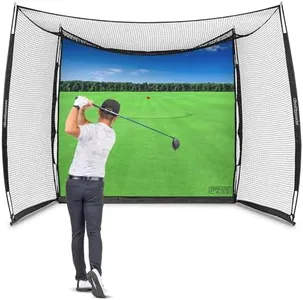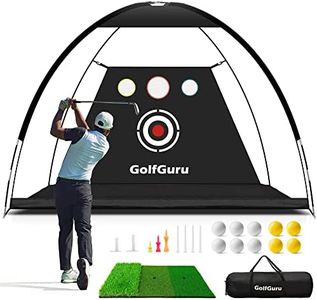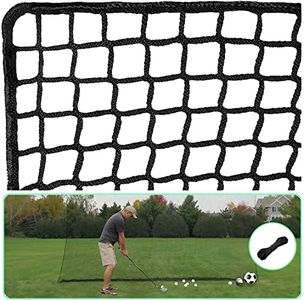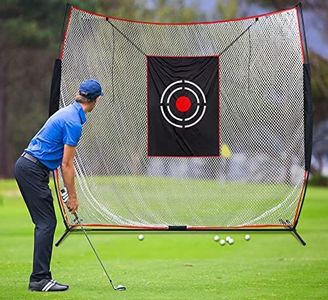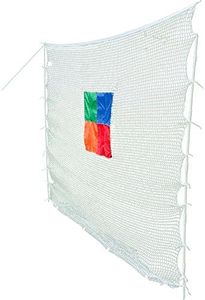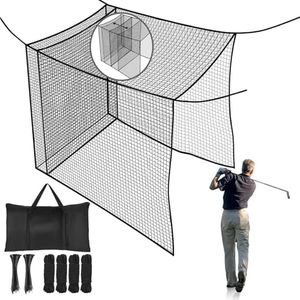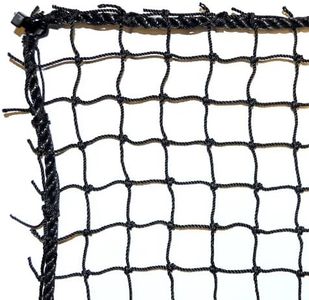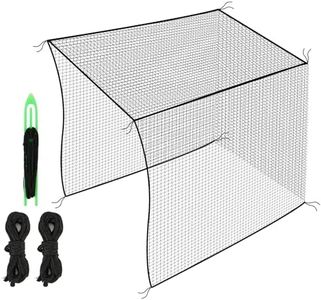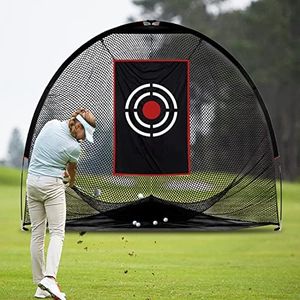We Use CookiesWe use cookies to enhance the security, performance,
functionality and for analytical and promotional activities. By continuing to browse this site you
are agreeing to our privacy policy
10 Best Golf Cage Nets
From leading brands and best sellers available on the web.Buying Guide for the Best Golf Cage Nets
Choosing the right golf cage net can make a big difference in your practice or training experience. A high-quality net keeps you safe, protects your property, and ensures your practice is effective and convenient. Before you buy, consider how much space you have, whether it will be set up indoors or outdoors, and how often you'll use it. Understanding the most important specifications will help you select a net that truly fits your needs and delivers years of reliable use.Net MaterialNet material refers to the type of fibers or threads used to create the golf cage net, and it's important because it determines the net's durability, weather resistance, and capacity to stop golf balls safely. The most common materials are nylon, polyester, and polyethylene. Nylon nets are strong and flexible, great for heavy use and outdoor settings but can degrade in constant sunlight. Polyester nets tend to resist sunlight and moisture a bit better, making them a good all-purpose choice. Polyethylene is more affordable but might not last as long with frequent use. If you'll be hitting frequently or at high speeds, or leaving the net outdoors, choose a material known for longevity and weather resistance. For lighter indoor use, any material should suffice.
Netting Thickness (or Gauge)Netting thickness (sometimes called gauge) measures how thick and sturdy the threads of the net are. This matters because thicker nets better absorb the impact of powerful hits and last longer, while thinner nets are lighter and easier to move. Thickness usually ranges from 1.5mm for basic practice to over 3mm for heavy-duty cages used by experienced players. If you're a beginner or using real balls with moderate force, a standard thickness should be fine. If you tend to swing hard, or want to practice with high-velocity shots, choose a thicker netting to ensure safety and longevity.
Mesh SizeMesh size is the size of the openings in the net. Smaller mesh sizes prevent even the smallest practice balls from passing through, enhancing safety, especially for indoor or close-quarter use. Mesh sizes commonly range from about 3/4 inch to 1.5 inches. For general golf practice with standard balls, a mesh size around 1 inch is typical. If you're using smaller balls or want the greatest protection for people and property behind the cage, opt for a tighter, smaller mesh.
Frame MaterialFrame material is what holds the net in place, and it's important for both stability and portability. Frames are commonly made from steel or fiberglass. Steel frames are sturdy and handle outdoor weather well, though they can be heavier and less portable. Fiberglass is lighter and easier to set up or move, but may not offer as much stability for permanent outdoor setups. If you’re setting up the net in one spot, a steel frame may be best. If you need to move or store the net often, a lighter frame is more practical.
Size and ShapeSize and shape determine how much room you'll have for swinging and how well the net will catch shots. Larger cages offer more freedom and safety but require more space. Standard cages are often 10’x10’x10’ but can be much smaller or larger. Rectangular cages give good area coverage, while some nets are curved or angled for ball return. If you have limited space indoors or in your yard, carefully measure before buying. Always select a size that allows for full swings and safely contains all stray balls.
Weather ResistanceWeather resistance is the net and frame's ability to withstand rain, sunlight, wind, and temperature changes. For outdoor users, this is crucial so the net doesn’t degrade too quickly. Look for UV-resistant netting and frames with rustproof coatings or materials. If your net will remain outside, make sure both net and frame are designed for weather resistance. For indoor-only use, this feature is less important.
Ease of Setup and PortabilityEase of setup and portability refers to how quickly you can put up or take down the golf cage net, and how easy it is to move. Some nets require tools and multiple people to assemble, while others are designed for quick solo setup. If you’ll need to regularly set up and take down the net, choose a design that is lightweight and has a simple assembly process. For a more permanent practice area, a fixed and sturdy design may be preferable, even if it’s less portable.
